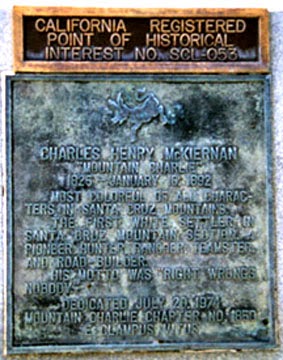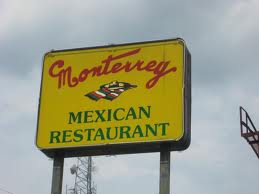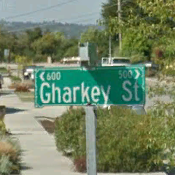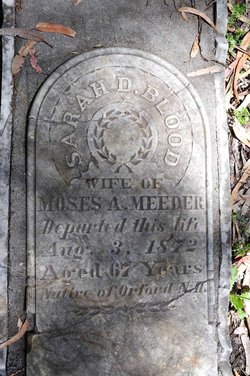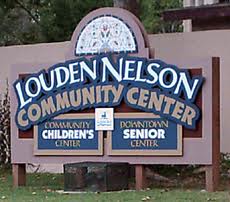History Pages: 40 - What's in a Name? – Adventures in Spelling
For a table of contents, see History pages.
The History Pages have attempted to number articles in approximate chronological order. A few have been left out of the number sequence because they were digressions - usually made to comment on a topical story or event that tied into local history in some way. Even though this one is not tied to a specific date or range of dates, its subjects fall into the pre-1880 period, so it gets a number now.
The previous History Page, mentioning “Mountain Charley” McKiernan, elicited a comment from a reader who contended that the proper spelling is “Charlie” rather than “Charley” (because that's how the street sign and historical plaque spell it). Either spelling is fine. Another one was "Colegrove" vs. "Colgrove". Spelling questions have come up frequently during research of these subjects. In fact, the evolution of name spellings is one of the challenges that confront any historical researcher.
The farther back you go in history, the greater the changes. For example, read some history of the ancient Roman Empire, then look at a modern map and try to find those Roman places from 2000 years ago. Except for Roma itself, most of the names have changed beyond recognition (if the Roman places still exist at all). By comparison, our task in researching Santa Cruz history is much easier, since we don’t have much written history more than 200 years old. Of course, a lot of the oldest written material is in Spanish, which presents its own difficulties.
The earliest spelling challenges encountered in Santa Cruz history involve the transliteration of indigenous native spoken-language words (they had no written languages) place names into Spanish - by the early explorers and missionaries. A prime example is Soquel, for which Donald Clark found 14 different spellings in historical sources. Out of those 14, my favorite is Osocales - it has that Spanish musicality.
Another translation-related source of confusion is with early non-Spanish-speaking residents who became Mexican citizens and appear in early documents with Spanish versions of their names. For instance, the Englishman William Buckle can be found in early documents as Guillermo Bocle.
Less explicable spelling changes have happened to other Spanish/Mexican names. For instance, the old Rancho San Andres is now remembered only by San Andreas Road. How and when did that extra "a" happen? Another mystery is how Vizcaíno’s Monterrey Bay lost one of its “r”s somewhere along the way. Mexican restaurants seem to be able to get it right - probably because the use the name of the city in Mexico.
Some native speakers of other non-English languages intentionally changed the spelling of their names, in an attempt to help Americans pronounce them. The German-born Frederick Hühn, recognizing that Americans could not properly pronounce his name, changed the spelling to Hihn. That was partially successful - today’s residents of Hihn Road in Ben Lomond tend to pronounce it as “Heen”, which is not quite German but closer than “Hoon” or “Hun”.
Another example of problematic German pronunciation was Ohio native David Gharky. Gharky has been mentioned in these Pages previously as one of the early Santa Cruz wharf builders. A Google search on the name shows that many Gharkys still live in Ohio, and that the German original family name is spelled Gehrcke. So the Gehrcke family changed the spelling even before David came to Santa Cruz. Nice try – but it still wasn’t enough to stop the confusion. An 1856 California state legislature resolution authorizing the building of the wharf in Santa Cruz spelled his name Girky. As a final indignity, the Westside street that remembers David’s name today is spelled Gharkey. At least it's in an appropriate location - the area surrounding the street was once owned and subdivided by Gharky.
Those German surnames seem to have been especially problematic in Santa Cruz, maybe because a fairly large number of native Germans moved to this area in the period from 1846 to 1871 (German emigration to this area seems to have tapered off after the Franco-Prussian War). Another example was the beachfront bathhouse pioneer Liebbrandt brothers. One of the "b"s disappeared when a Beach Flats street was named for him, in the neighborhood where they lived.
Spelling continued to be a problem even after several generations in America, as the Gharky story illustrates. Moses Meder, a well-known pioneer and one of the first County supervisors, is another example. He was born in New Hampshire, where his family had lived for several generations. Yet, in some local historical records, we find his name spelled Meader. On his wife Sarah’s headstone, it’s spelled Meeder. In Meder's case, the Santa Cruz street sign is where you'll find the correct spelling.
Finally, there’s the case of the ex-slave London Nelson, who is remembered for leaving his entire modest estate to the Santa Cruz school district. Apparently, the spelling of his first name is not entirely clear in hand-written probate records (any of us who have looked at old census records understand that problem).
In the 1930s, Nelson’s wooden grave marker at Evergreen Cemetery was replaced with one made of marble, a generous act by someone. The stone-cutter, however, was apparently given the spelling “Louden Nelson” (or he made the mistake himself), and that spelling has persisted ever since. In 2021, the Santa Cruz City Council finally decided to rectify that misspelling, so the name on the community center sign will soon change (the sign itself has already been replaced once since the version shown here).
When we think about how future generations will remember us (if we think about that at all), we don’t usually worry about them misspelling our names. In today’s world, such an occurrence is less likely, but it’s a normal part of historical/genealogical research.
Sources
- Clark, Donald Thomas. Santa Cruz County Place Names (expanded 2nd edition 2008 - available at SCPL)
- Santa Cruz Public Library, online local history articles
Next: History Pages: 40 - Approaching the Gilded Age: Santa Cruz Enters the 1880s
